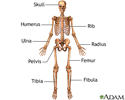Acrodysostosis
Arkless-Graham; Acrodysplasia; Maroteaux-Malamut
Acrodysostosis is an extremely rare disorder that is present at birth (congenital). It leads to problems with the bones of the hands, feet, and nose, and intellectual disability.
Causes
Most people with acrodysostosis have no family history of the disease. However, sometimes the condition is passed down from parent to child. Parents with the condition have a 1 in 2 chance of passing the disorder to their children.
There is a slightly greater risk with fathers who are older.
Symptoms
Symptoms of this disorder include:
- Frequent middle ear infections
- Growth problems, short arms and legs
- Hearing problems
- Intellectual disability
- The body doesn't respond to certain hormones, even though hormone levels are normal
- Distinct facial features
Exams and Tests
The health care provider can usually diagnose this condition with a physical exam. This may show any of the following:
- Advanced bone age
- Bone deformities in hands and feet
- Delays in growth
- Problems with the skin, genitals, teeth, and skeleton
- Short arms and legs with small hands and feet
- Short head, measured front to back
- Short height
- Small, upturned broad nose with flat bridge
- Distinct features of the face (short nose, open mouth, jaw that sticks out)
- Unusual head
- Wide-spaced eyes, sometimes with extra skin fold at corner of eye
In the first months of life, x-rays may show spotty calcium deposits, called stippling, in bones (especially the nose). Infants may also have:
- Abnormally short fingers and toes
- Early growth of bones in the hands and feet
- Short bones
- Shortening of the forearm bones near the wrist
Two genes have been linked with this condition, and genetic testing may be done.
Treatment
Treatment depends on the symptoms.
Hormones, such as growth hormone, may be given. Surgery to treat bone problems may be done.
Support Groups
These groups can provide more information on acrodysostosis:
- National Organization for Rare Disorders -- rarediseases.org/rare-diseases/acrodysostosis
- NIH Genetic and Rare Diseases Information Center -- rarediseases.info.nih.gov/diseases/5724/acrodysostosis
Outlook (Prognosis)
Problems depend on the degree of skeletal involvement and intellectual disability. In general, people do well.
Possible Complications
Acrodysostosis may lead to:
- Learning disability
- Arthritis
- Carpal tunnel syndrome
- Worsening range of movement in the spine, elbows, and hands
When to Contact a Medical Professional
Contact your child's provider if signs of acrodystosis develop. Make sure your child's height and weight are measured during each well-child visit. The provider may refer you to:
- A genetic professional for a full evaluation and chromosome studies
- A pediatric endocrinologist for management of your child's growth problems
References
Jones KL, Jones MC, del Campo M. Other skeletal dysplasias. In: Jones KL, Jones MC, del Campo M, eds. Smith's Recognizable Patterns of Human Malformation. 8th ed. Philadelphia, PA: Elsevier; 2022:600-637.
National Organization for Rare Disorders website. Acrodysostosis. rarediseases.org/rare-diseases/acrodysostosis. Updated August 13, 2014. Accessed November 28, 2022.
Review Date: 10/13/2022
Reviewed By: Anna C. Edens Hurst, MD, MS, Associate Professor in Medical Genetics, The University of Alabama at Birmingham, Birmingham, AL. Review provided by VeriMed Healthcare Network. Also reviewed by David C. Dugdale, MD, Medical Director, Brenda Conaway, Editorial Director, and the A.D.A.M. Editorial team.





